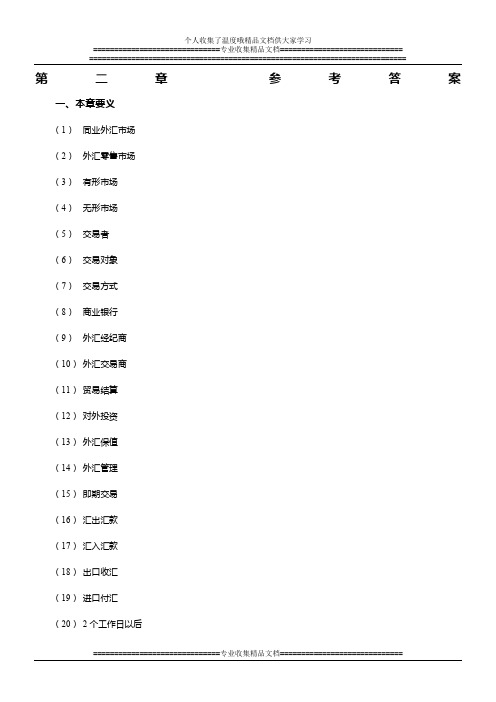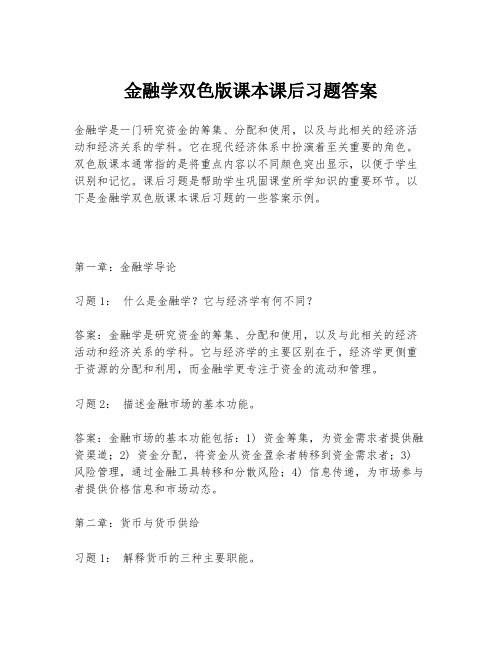金融学双语第二章 课后习题
- 格式:docx
- 大小:26.71 KB
- 文档页数:1

Short Dialogs Task 1 Multiple Choice Scripts & AnswersDialog 1W: Why can’t I tell interest rate from exchange rate? Who can help me?M: Well, It is not as difficult as you think. There is a simple way to tell the difference. When you deposit money with a bank or borrow money froma bank, you usually earn or pay interest at the set interest rate. If you go toexchange RMB for some foreign currency, you’ll need to know the currentexchange rate of RMB to that currency. Have you got it?W: Yeah, I think I’ve got it. The interest rate is the price of local currency onthe local market and the exchange rate is the price of one currency againstanother one on the foreign exchange market.Question: When will exchange rate be used according to the man? (D)女:我怎么就区分不了利率和汇率呢? 谁能帮帮我?男:别着急。
没有你想得那么难。
有个简单方法可以区别它们。
当你把钱存到银行或者仍银行贷款时,你会按规定的利率赚得利息或支付利息。

Financial Markets and Institutions^ 8e (Mishkin)Chapter 1 Why Study Financial Markets and Institutions?1.1Multiple Choice1)Financial maikets and institutionsA)involve the movement of huge quantities of money.B)affect the profits of businesses.C)affect the types of goods and sendees produced in an economy.D)do all of the above.E)do only A and B of the above.Answer: DTopic: Chapter 1.1 Why Study Fmancial MaiketsQuestion Status: Previous Edition2)Financial maiket activities affectA)peisonal wealth.B)spendmg decisions by individuals and busuiess films.C)the econom^s location in the business cycle.D)all of the above.Answer: DTopic: Chapter 1.1 Why Study Fmancial MaiketsQuestion Status: Previous Edition3)Maikets m which hinds are transfened fiom those who have excess fiinds available to those who have a shortage of available fluids are calledA)conunodity maikets.B)fluids maikets.C)derivative exchange maikets.D)financial maikets.Answer: DTopic: Chapter 1.1 Why Study Fmancial MaiketsQuestion Status: Previous Edition4)The price paid fbr the rental of bonowed fluids (usually expressed as a percentage of the rental of $100 per year) is conunoiily lefened to as theA)inflation rate.B)exchange rate.C)interest rate.D)aggregate price level.Answer: CTopic: Chapter 1.1 Why Study Fmancial MaiketsQuestion Status: Previous Edition5)The bond maikets are impoitant becauseA)they are easily the most widely followed financial maikets m the Umted States.B)they are the maikets where mteiest rates are detemiined.C)they are the maikets where foreign exchange rates are detemimed.D)all of the above.Answer: BTopic: Chapter 1.1 Why Study Fmancial MaiketsQuestion Status: Previous Edition6)hiterest rates are impoilant to financial institutions since an interest rate mcrease the cost of acquumg fiinds and the income from assets.A)decreases; decreasesB)mcieases; increasesC)decreases; incieasesD)increases; decreasesAnswer: BTopic: Chapter 1.1 Why Study Fmancial MaiketsQuestion Status: Previous Edition7)Typically, increasing mteiest ratesA)discourages individuals fiom saving.B)discourages coiporate mvestments.C)encourages corporate expansion.D)encourages corporate bonowing.E)none of the above.Answer: BTopic: Chapter 1.1 Why Study Fmancial MaiketsQuestion Status: Previous Edition8)Compaied to mteiest rates on long-term U.S. govenmient bonds, interest rates on fluctuate more and are lower on average.A)medium-quality coiporate bondsB)low-quality coiporate bondsC)lugh-quality coiporate bondsD)tluee-montli Treasuiy billsE)none of the aboveAnswer: DTopic: Chapter 1.1 Why Study Fmancial MaiketsQuestion Status: Previous Edition9)Compaied to mterest rates on long-term U.S. govenmient bonds, interest rates on tluee-month Treasury bills fluctuate and are on average.A)more; lowerB)less; lowerC)more; lugherD)less; higherAnswer: ATopic: Chapter 1.1 Why Study Fmancial MarketsQuestion Status: Previous Edition10)The stock maiket is important becauseA)it is where interest rates are determined.B)it is the most widely followed financial maiket in the United States.C)it is where foreign exchange rates are deteimined.D)all of the above.Answer: BTopic: Chapter 1.1 Why Study Fmancial MarketsQuestion Status: Previous Edition11)Stock prices smce the 1980s have beenA)relatively stable, trending upward at a steady pace.B)relatively stable, tiending downward at a moderate rate.C)extiemely volatile.D)unstable, trendmg downwaid at a moderate rate.Answer: CTopic: Chapter 1.1 Why Study Fmancial MarketsQuestion Status: Previous Edition12)The largest one-day drop m the histoiy of the Aineiican stock markets occuned in A) 1929.B)1987.C)2000.D)2001.Answer: BTopic: Chapter 1.1 Why Study Fmancial MarketsQuestion Status: Previous Edition13) A declining stock market index due to lower share pricesA)reduces people's wealth and as a result may reduce then willingness to spend.B)mcieases people's wealth and as a result may increase their willmgness to spend.C)decreases the amount of hinds that business films can raise by sellmg newly issued stock.D)both A and C of the above.E)both B and C of the above.Answer: DTopic: Chapter 1.1 Why Study Fmancial MarketsQuestion Status: Previous Edition14)Changes m stock pricesA)affect people's wealth and their willmgness to spend.B)affect films' decisions to sell stock to finance investment spending.C)are chaiacteiized by considerable fluctuations.D)all of the above.E)only A and B of the above.Answer: DTopic: Chapter 1.1 Why Study Fmancial MarketsQuestion Status: Previous Edition15)(I) Debt maikets are often refened to genencally as the bond maiket.(II) A bond is a security that is a claim on the earnings and assets of a corporation.A)(I) is tine, (II) false.B)(I) is false, (II) tine.C)Both are tme.D)Both are false.Answer: ATopic: Chapter 1.1 Why Study Fmancial MaiketsQuestion Status: Previous Edition16) (I) A bond is a debt secunty that pionuses to make payments peiiodically for a specified penod of tune. (II) A stock is a secunty that is a claim on the eanimgs and assets of a coipoiation.A)(I) is true, (II) false.B)(I) is false, (II) tine.C)Both are tme.D)Both are false.Answer: CTopic: Chapter 1.1 Why Study Fmancial MaiketsQuestion Status: Previous Edition17)The piice of one country's cunency in terms of anothei J s is calledA)the foreign exchange rate.B)the interest rate.C)the Dow Jones mdustrial average.D)none of the above.Answer: ATopic: Chapter 1.1 Why Study Fmancial MaiketsQuestion Status: Previous Edition18) A stronger dollar benefits and hints.A)Aineiican busuiesses; Aineiican consumeisB)Aineiican busmesses; foreign businessesC)Aineiican consumeis; Aineiican busmessesD)foreign businesses; Ameiican consumeisAnswer: CTopic: Chaptei 1.1 Why Study Fmancial MarketsQuestion Status: Previous Edition19) A weaker dollar benefits and hurts.A)Aineiican busmesses; Aineiican consumeisB)Aineiican busmesses; foieign consumersC)Aineiican consumeis; Aineiican busmessesD)foreign businesses; Ameiican consumersAnswer: ATopic: Chaptei 1.1 Why Study Fmancial MarketsQuestion Status: Previous Edition20)From 1980 to early 1985 the dollar in value, thereby benefitingAinencan.A)appreciated; businessesB)appreciated; consumersC)depreciated; businessesD)depreciated; consumersAnswer: BTopic: Chaptei 1.1 Why Study Fmancial MarketsQuestion Status: Previous Edition21)hi generaL fiom 2001 tluough 2013, the dollar m value relative tomajor foreign cuuencies.A)appreciatedB)depreciatedC)lemained about the sameAnswer: BTopic: Chaptei 1.1 Why Study Fmancial MarketsQuestion Status: New Question22)Money is defined asA)anythmg that is geneially accepted in payment fbr goods and sendees or in the repayment of debt.B)bills of exchange.C) a nskless repositoiy of spending power.D)all of the above.E)only A and B of the above.Answer: ATopic: Chaptei 1.2 Why Study Financial InstitutionsQuestion Status: Previous Edition23)The organization responsible fbf the conduct of monetaiy policy in the United States is theA)Comptioller of the Currency.B)U.S. Treasuiy.C)Federal Reserve System.D)Bureau of Monetaiy Affaus.Answer: CTopic: Chaptei 1.2 Why Study Fmancial InstitutionsQuestion Status: Previous Edition24)The central bank of the United States isA)Citicoip.B)The Fed.C)Bank of America.D)The Tieasuiy.E)none of the above.Answer: BTopic: Chaptei 1.2 Why Study Fmancial InstitutionsQuestion Status: Previous Edition25)Monetaiy policy is cluefly concerned withA)how much money businesses earn.B)the level of mterest rates and the nation's money supply.C)how much money people pay in taxes.D)whether people have saved enough money for letnement.Answer: BTopic: Chaptei 1.2 Why Study Fmancial InstitutionsQuestion Status: Previous Edition26)Econonusts group conuneicial banks, savings and loan associations, credit unions, mutual ftinds, mutual savings banks, msuiance companies, pension fiinds, and finance companies together under the heading financial inteniiedianes. Financial mtermedianes A)act as middlemen, bonowmg ftinds fiom those who have saved and lending these fluids to others.B)produce nothing of value and are therefore a drain on society's resoui ces.C)help promote a more efficient and dynamic economy.D)do all of the above.E)do only A and C of the above.Answer: ETopic: Chaptei 1.2 Why Study Fmancial InstitutionsQuestion Status: Previous Edition27)Econonusts group conuneicial banks, savings and loan associations, credit unions, mutual fiinds, mutual savings banks, msuiance companies, pension fiinds, and finance companies together under the heading financial inteimedianes. Financial mtermedianesA)act as middlemen, bonowmg fiinds fiom those who have saved and lending these fimds to others.B)play an important role in detemmuiig the quantity of money m the economy.C)help promote a more efficient and dynanuc economy.D)do all of the above.E)do only A and C of the above.Answer: DTopic: Chapter 1.2 Why Study Fmancial InstitutionsQuestion Status: Previous Edition28)Banks are unpoitant to the study of money and the economy because they A) provide a chaimel for Imkrng those who want to save with those who want to mvest.B)have been a source of financial nmovation that is expandmg the alternatives available to those wanting to mvest then money.C)are the only financial mstitution to play a role in detemuiHiig the quantity of money in the economy.D)do all of the above.E)do only A and B of the above.Answer: ETopic: Chapter 1.2 Why Study Fmancial InstitutionsQuestion Status: Previous Edition29)Banks, savings and loan associations, mutual savings banks, and credit unions A) are no longer unportant players in financial intemiediation.B)have been providing services only to small depositors since deregulation.C)have been adept at iimovating in response to changes in the regulatoiy envuomnent.D)all of the above.E)only A and C of the above.Answer: CTopic: Chapter 1.2 Why Study Fmancial InstitutionsQuestion Status: Previous Edition30)(I) Banks are financial intennediaiies that accept deposits and make loans.(II) The tenn n baiiks n includes films such as commercial banks, savmgs and loan associations, mutual savings banks, credit unions, msuiance companies, and pensionfluids.A)(I) is true, QI) false.B)(I) is false, (II) tine.C)Both are tme.D)Both are false.Answer: ATopic: Chapter 1.2 Why Study Fmancial InstitutionsQuestion Status: Previous Edition31)was the stock market^ worst one-day chop in histoiy in the 1980s.A)Black FridayB)Black MondayC)Blackout DayD)none of the aboveAnswer: BTopic: Chapter 1.1 Why Study Fmancial MarketsQuestion Status: Previous Edition32)The largest financial intennedianes areA)insuiance companies.B)finance compames.C)banks.D)all of the above.Answer: CTopic: Chapter 1.2 Why Study Financial InstitutionsQuestion Status: Previous Edition33)hi recent yearsA)interest rates have lemained constant.B)the success of financial institutions has leached levels unpiecedented smce the Great Depiession.C)stock markets have crashed.D)all of the above.Answer: CTopic: Chapter 1.1 Why Study Fmancial MarketsQuestion Status: Previous Edition34) A securityA)is a claun oi puce of propeity that is subject to ownership.B)piomises that payments will be made penodically fbr a specified penod of time.C)is the piice paid fbr the usage of ftinds.D)is a claun on the issuers fiituie mcome.Answer: DTopic: Chapter 1.1 Why Study Fmancial MarketsQuestion Status: Previous Edition35)are an example of a financial institution.A)BanksB)hisuiance companiesC)Fmance companiesD)All of the aboveAnswer: DTopic: Chapter 1.2 Why Study Fmancial InstitutionsQuestion Status: Previous Edition36)Monetaiy policy affectsA)interest rates.B)mflation.C)business cycles.D)all of the above.Answer: DTopic: Chapter 1.2 Why Study Fmancial InstitutionsQuestion Status: Previous Edition37) A using stock market index due to higher share pricesA)increases people's wealth and as a result may increase their willmgness to spend.B)uicieases the amount of fluids that business firms can raise by selling newly issued stock.C)decreases the amount of hinds that business films can raise by selling newly issued stock.D)both A and B of the above.Answer: DTopic: Chapter 1.1 Why Study Fmancial MarketsQuestion Status: Previous Edition38)From the peak of the high-tech bubble in 2000, the stock market byovei by late 2002.A)collapsed; 75%B)rose; 35%C)collapsed; 30%D)rose; 50%Answer: CTopic: Chapter 1.1 Why Study Fmancial MarketsQuestion Status: Previous Edition39)The Dow fell below 7,000 m 2009, only to start a bull market run, reaching new highs above m 2013.A)12,000B)10,000C) 15,000D) 19,000Answer: CTopic: Chapter 1.1 Why Study Fmancial MarketsQuestion Status: New Question1.2 Tme/False1)Money is anything accepted by anyone as payment fbr services or goods.Answer: TRUETopic: Chapter 1.2 Why Study Fmancial InstitutionsQuestion Status: Previous Edition2)hiterest rates are determined in the bond markets.Answer: TRUETopic: Chapter 1.1 Why Study Fmancial MarketsQuestion Status: Previous Edition3) A stock is a debt secuiity that promises to make penodic payments fbr a specific period of time.Answer: FALSETopic: Chapter 1.1 Why Study Fmancial MarketsQuestion Status: Previous Edition4)Monetaiy policy affects interest rates but has little effect on inflation oi busmess cycles.JAnswer: FALSETopic: Chapter 1.2 Why Study Fmancial InstitutionsQuestion Status: Previous Edition5)The govenunent orgamzation lesponsible for the conduct of monetaiy policy m the United States is the U.S. Treasuiy.Answer: FALSETopic: Chapter 1.2 Why Study Financial InstitutionsQuestion Status: Previous Edition6)hiterest rates can be accuiately described as the rental price of money.Answer: TRUETopic: Chapter 1.1 Why Study Fmancial MarketsQuestion Status: Previous Edition7)Holding eveiytliuig else constant, as the dollar weakens vacations abroad become less attractive.Answer: TRUETopic: Chapter 1.1 Why Study Fmancial MarketsQuestion Status: Previous Edition8)In recent years, financial markets have become more stable and less risky. Answer: FALSETopic: Chapter 1.1 Why Study Fmancial MarketsQuestion Status: Previous Edition9)Financial innovation lias provided more options to both mvestors and bonowers. Answer: TRUETopic: Chaptei 1.1 Why Study Fmancial MarketsQuestion Status: Previous Edition10) A financial mtennediaiy borrows fiinds fiom people who have saved.Answer: TRUETopic: Chaptei 1.2 Why Study Fmancial InstitutionsQuestion Status: Previous Edition11)Holding eveiything else constant, as the dollar strengthens fbieigneis will buy more U.S. exports.Answer: FALSETopic: Chaptei 1.1 Why Study Fmancial MarketsQuestion Status: Previous Edition12)In a bull market stock prices are rising, on average.Answer: TRUETopic: Chaptei 1.1 Why Study Fmancial MarketsQuestion Status: Previous Edition13)Financial institutions are among the largest employers m the country and fiequently pay very high salaries.Answer: TRUETopic: Chaptei 1.3 Applied Managerial PerspectiveQuestion Status: Previous Edition14)Different interest rates have a tendency to move in unison.Answer: TRUETopic: Chaptei 1.1 Why Study Fmancial MarketsQuestion Status: Previous Edition15)Financial markets are what makes financial mstitutions work.Answer: FALSETopic: Chaptei 1.1 Why Study Fmancial MarketsQuestion Status: Previous Edition16)In recent years, financial markets have become more iisky. However, only a linuted number of tools (such as deiivatives) are available to assist in managing this lisk. Answer: FALSETopic: Chaptei 1.1 Why Study Fmancial MarketsQuestion Status: Previous Edition17)Although the internet has changed many aspects of oui lives, it hasn't proven veiy usefill for collectmg and/oi analyzmg financial and econonuc data.Answer: FALSETopic: Chapter 1.4 How We Study Fmancial Markets and InstitutionsQuestion Status: New Question1.3 Essay1)Have inteiest rates been more or less volatile m recent years? Why?Topic: Chapter 1.1 Why Study Fmancial MarketsQuestion Status: Previous Edition2)Why should consumers be concerned with movements in foreign exchange rates?Topic: Chapter 1.1 Why Study Fmancial MarketsQuestion Status: Previous Edition3)How does the value of the dollar affect the competitiveness of Aineiican busmesses? Topic: Chapter 1.1 Why Study Fmancial MarketsQuestion Status: Previous Edition4)What is monetaiy policy and who is responsible fbi its implementation?Topic: Chapter 1.2 Why Study Fmancial InstitutionsQuestion Status: Previous Edition5)What are financial intennediaiies and what do they do?Topic: Chapter 1.2 Why Study Fmancial InstitutionsQuestion Status: Previous Edition6)What is money?Topic: Chapter 1.1 Why Study Fmancial MarketsQuestion Status: Previous Edition7)How does a bond differ fiom a stock?Topic: Chapter 1.1 Why Study Fmancial MarketsQuestion Status: Previous Edition8)Why is the stock market so important to individuals, films, and the economy? Topic: Chapter 1.1 Why Study Fmancial MarketsQuestion Status: Previous Edition9)What is the cential bank and what does it do?Topic: Chapter 1.2 Why Study Fmancial InstitutionsQuestion Status: Previous Edition10)If you are plaiming a vacation to Europe, do you prefer a strong dollar or weak dollar relative to the euio? Why?JTopic: Chapter 1.1 Why Study Fmancial MarketsQuestion Status: Previous Edition11)How has the stock market peifbimed smce 2000?Topic: Chapter 1.1 Why Study Fmancial MarketsQuestion Status: New Question。
![金融学精编版第二版[货币银行学]第2章课后答案](https://img.taocdn.com/s1/m/c4057f35f78a6529657d5339.png)
第二章信用1.你过去对于信用这个经济范畴是怎样理解的?应该怎样界定信用较好?答:(1)过去对信用这个经济范畴的理解是,信用相当于“借贷”或“债”的概念,等等。
(2)按照下面的方式来界定信用比较好:信用这个经济范畴是指借贷行为。
从逻辑上推论,私有财产是的出现是借贷关系存在的前提条件。
这种经济行为的形式特征是以收回为条件的付出,或以归还为义务的取得;而且贷者之所以贷出,是因为有权取得利息,借者之所以可能借入,是因为承担了支付利息的义务。
现实生活中有时也有无利息的借贷,但这是由于某种政治目的或经济目的而采取的免除利息的优惠,是一般中的特殊。
西方不少国家的银行对企业的活期存款也往往不支付利息,但存款者可以享受银行的有关服务和取得贷款的某些权利,实际上还是隐含有利息的。
2.经济学意义上的“信用”,与日常生活和道德规范里的“信用”,有没有关系,是怎样的关系?答:道德范畴中的“信用”指的是诚信,是经济主体通过诚实履行自己承诺而取得他人的信任。
从经济意义上看,信用的含义就转化和延伸为以借贷为特征的经济行为,是以还本付息为条件的,体现着特定的经济关系。
它既区别于一般商品货币交换的价值运动形式,又区别于财政分配等其他特殊的价值运动形式,是不发生所有权变化的价值单方面的暂时让渡或转移。
这两个范畴的信用密切相关。
诚信是交易、支付和借贷活动得以顺利进行的基础。
借贷活动是以收回为条件的付出,或以归还为义务的取得;而且贷者之所以贷出,是因为有权取得利息,借者之所以可能借入,是因为承担了支付利息的义务。
如果没有当事人之间的最基本的信任,就不会发生借贷活动。
诚信是借贷活动的基础。
如果失信成为信用行为中的主导方面,借贷活动就会萎缩甚至中断。
而借贷活动的发展,使得经济活动参与者日益意识到诚信的重要性,进而使诚信成为经济生活的重要准则之一。
3.为什么说在现代经济生活中,信用联系几乎无所不在,以至可以称为“信用经济”?能否谈谈你本人的体验?答:(1)将现代经济说成信用经济是对现代经济的一种描述。


第二章参考答案一、本章要义(1)同业外汇市场(2)外汇零售市场(3)有形市场(4)无形市场(5)交易者(6)交易对象(7)交易方式(8)商业银行(9)外汇经纪商(10)外汇交易商(11)贸易结算(12)对外投资(13)外汇保值(14)外汇管理(15)即期交易(16)汇出汇款(17)汇入汇款(18)出口收汇(19)进口付汇(20)2个工作日以后(21)1-3个月(22)即期汇率(23)利率差异(24)远期期限(25)买进(26)卖出(27)即期交易(28)远期交易二、释义选择1.K2.L3.C、D 4.M5.R6.H7.P8.E9.U10.T11.O12.Q13.B14.S15.I16.A17.F18.G三、判断对错TFTFF TFFTF四、不定项选择1.ACDE2.ABD3.AB4.BCDE5.BCEFG6.ACDF五、问答题1.外汇市场有哪些功能?答:外汇市场作为国际经济联系的纽带,集中地反映了国际经济、国际金融的动态和各国汇率变化的趋势,外汇市场为促进国际贸易的发展,国际投资和各种国际经济往来的实现提供了便利条件。
其功能主要表现在以下方面:(1)反映和调节外汇供求。
一国对外经济、贸易的收支以及资本金融项目的变化都最终反映到外汇市场供求状况上,政府、企业、个人通过外汇市场可以解决自己的外汇供求问题。
(2)形成外汇价格体系。
银行接受顾客买卖外汇后,需要在银行间市场进行调节,因而自然产生外汇的供需,加上银行本身自发性的供需,在市场通过竞价过程,便会产生汇率,随后,银行对顾客交易的汇率再根据上述银行间成交汇率加以确定。
(3)实现购买力的国际转移。
结清国际债权债务关系,实现货币购买力的国际转移,是外汇市场最基本的功能。
(4)提供外汇资金融通。
外汇市场是理想的外汇资金集散中心,从而成为世界资本再分配的重要渠道,为银行外汇业务提供平衡头寸的蓄水池作用。
限制的外汇资金大量涌向外汇市场,为外汇需求者提供越来越多的可筹资金,还对促进国际贸易发展,促进投资的国际化起着不可忽视的作用。

金融学双色版课本课后习题答案金融学是一门研究资金的筹集、分配和使用,以及与此相关的经济活动和经济关系的学科。
它在现代经济体系中扮演着至关重要的角色。
双色版课本通常指的是将重点内容以不同颜色突出显示,以便于学生识别和记忆。
课后习题是帮助学生巩固课堂所学知识的重要环节。
以下是金融学双色版课本课后习题的一些答案示例。
第一章:金融学导论习题1:什么是金融学?它与经济学有何不同?答案:金融学是研究资金的筹集、分配和使用,以及与此相关的经济活动和经济关系的学科。
它与经济学的主要区别在于,经济学更侧重于资源的分配和利用,而金融学更专注于资金的流动和管理。
习题2:描述金融市场的基本功能。
答案:金融市场的基本功能包括:1) 资金筹集,为资金需求者提供融资渠道;2) 资金分配,将资金从资金盈余者转移到资金需求者;3) 风险管理,通过金融工具转移和分散风险;4) 信息传递,为市场参与者提供价格信息和市场动态。
第二章:货币与货币供给习题1:解释货币的三种主要职能。
答案:货币的三种主要职能是:1) 价值尺度,货币作为衡量商品和服务价值的标准;2) 交易媒介,货币在买卖交易中充当支付手段;3) 贮藏手段,货币可以作为财富的存储形式。
习题2:如何理解货币供给的多渠道?答案:货币供给的多渠道指的是货币可以通过不同的途径进入经济体系。
这包括中央银行的货币发行、商业银行的信贷创造、以及通过外汇市场和其他金融市场的货币流动。
第三章:利率与资本市场习题1:利率是如何影响经济活动的?答案:利率是资金的价格,它影响着储蓄和投资的决策。
高利率会抑制投资,因为借贷成本增加;而低利率则鼓励投资和消费,从而刺激经济增长。
习题3:描述债券市场的基本原理。
答案:债券市场是发行和交易债券的场所。
债券是一种金融证券,代表着债务关系,债券发行者(债务人)向购买者(债权人)借款,并承诺在未来的某个时间点偿还本金并支付利息。
...结语:金融学是一个不断发展和变化的领域,随着全球经济的不断演变,金融学的理论、方法和实践也在不断更新。
第一章货币与货币制度一、单项选择题1.B2.C3.B4.C5.A6.B7.C二、多项选择题1.ACDE2.CDE3.CD4.ABCD5.ABCDE6.ABCD三、简答题1. 货币的职能有哪些?价值尺度;流通手段;支付手段;贮藏手段;世界货币2. 人民币制度包括哪些内容?(1)人民币是我国的法定货币;(2)人民币是我国唯一的合法通货;(3)人民币的发行权集中于中央银行;(4)人民币以商品物资作为发行的首要保证,也以大量的政府政府债券、商业票据、商业银行票据等为发行的信用保证,还有黄金、外汇储备等也是人民币发行的现金保证;(5)人民币实行有管理的货币制度;(6)人民币称为可兑换货币。
3. 货币制度的构成要素是什么?货币材料;货币单位;各种通货的铸造、发行和流通程序;准备制度4. 不兑现的信用货币制度有哪些特点?(1)不兑现信用货币一般由中央银行发行,并由国家赋予其无限法偿能力,这是不兑现信用货币制度最基本的特点;(2)信用货币不与任何金属保持等价关系,也不能兑换黄金;(3)货币通过信用程序投入流通领域;(4)信用货币制度是一种管理货币制度;5. 钱、货币、通货、现金是一回事吗?银行卡是货币吗?不一样。
(1)钱的概念在不同场景下有很多不同的意思。
可以是个收入的概念、也可以是个财富的概念,也可以特指现金货币;(2)货币是在商品劳务交换与债券债务清偿时,被社会公众所普遍接受的东西。
(3)通货是流通中的货币,指流通与银行体系之外的货币。
范围小于货币。
(4)现金就是现钞,包括纸币、硬币。
现金是货币的一部分,流动性很强,对人们的日常消费影响很大。
(5)银行卡本身也称为“塑料货币”,包括信用卡、支票卡,记账卡、自动出纳机卡等。
银行卡可以用于存取款和转账支付。
在发达西方国家,各种银行卡正在取代现钞和支票,称为经济生活中广泛的支付工具,因此现代社会银行卡也是货币6.社会经济生活中为什么离不开货币?为什么自古至今,人们又往往把金钱看做说万恶之源?(1)社会经济生活离不开货币,货币的产生和发展都有其客观必然性。
金融学第二版课后习题答案金融学第二版课后习题答案金融学是一门研究金融市场、金融机构和金融工具的学科,它对于理解和解决现代金融问题具有重要意义。
而课后习题则是帮助学生巩固所学知识、提高解决问题能力的重要工具。
本文将为读者提供金融学第二版课后习题的答案,以帮助读者更好地理解金融学的概念和理论。
第一章:金融的基本概念和职能1. 金融的基本概念是指金融的定义和范围。
金融的定义是指金融活动和金融制度的总称。
金融的范围包括金融市场、金融机构和金融工具等。
2. 金融的职能是指金融对于经济发展和社会进步的作用。
金融的主要职能包括储蓄和融资、支付和结算、风险管理和信息中介等。
第二章:金融市场1. 金融市场的分类包括货币市场、资本市场和衍生品市场等。
货币市场是指短期资金融通的市场,资本市场是指长期资金融通的市场,衍生品市场是指金融衍生品交易的市场。
2. 金融市场的功能包括资源配置、风险管理和信息传递等。
资源配置是指将资金从供给者转移给需求者的过程,风险管理是指通过金融市场进行风险的转移和分散,信息传递是指金融市场通过价格和交易信息传递经济信息。
第三章:金融机构1. 金融机构的分类包括银行、非银行金融机构和金融市场机构等。
银行是最重要的金融机构,它包括商业银行、中央银行和政策性银行等。
2. 金融机构的职能包括储蓄和融资、支付和结算、风险管理和信息中介等。
储蓄和融资是指金融机构接受存款并提供贷款的过程,支付和结算是指金融机构提供支付和结算服务的过程,风险管理是指金融机构通过风险评估和风险转移来管理风险,信息中介是指金融机构通过收集、加工和传递信息来提供金融服务。
第四章:金融工具1. 金融工具的分类包括货币工具、债券、股票和衍生品等。
货币工具是指短期借贷和短期投资的金融工具,债券是指借款人向债权人发行的债务凭证,股票是指公司向股东发行的所有权凭证,衍生品是指衍生自其他金融资产的金融工具。
2. 金融工具的特点包括流动性、收益性和风险性等。
第一章货币概述货币量层次划分:货币量层次划分,即是把流通中的货币量,主要按照其流动性的大小进行相含排列,分成若干层次并用符号代表的一种方法。
价值尺度:货币在表现商品的价值并衡量商品价值量的大小时,发挥价值尺度的职能。
这是货币最基本、最重要的职能。
价格标准:指包含一定重量的贵金属的货币单位。
在历史上,价格标准和货币单位曾经是一致的,随着商品经济的发展,货币单位名称和货币本身重量单位名称分离了。
货币制度:货币制度简称“币制”,是一个国家以法律形式确定的该国货币流通的结构、体系与组织形式。
它主要包括货币金属,货币单位,货币的铸造、发行和流通程序,准备制度等。
金本位制:金本位制又称金单本位制,它是以黄金作为本位货币的一种货币制度。
其形式有三种金币本位制、金块本位制和金汇兑本位制。
无限法偿:即在货币收付中无论每次支付的金额多大,用本位币支付时,受款人不得拒绝接受,也即本位币具有无限的法定支付能力,即无限法偿。
有限法偿:有限法偿是指,货币在每一次支付行为中使用的数量受到限制,超过限额的部分,受款人可以拒绝接受。
格雷欣法则:即所谓“劣币驱逐良币”的规律。
就是在两种实际价值不同而面额价值相同的通货同时流通的情况下,实际价值较高的通货(所谓良币)必然会被人们熔化、输出而退出流通领域;而实际价值较低的通货(所谓劣币)反而会充斥市场。
6.什么是货币量层次划分,我国划分的标准和内容如何?(1)所谓货币量层次划分,即是把流通中的货币量,主要按照其流动性的大小进行相含排列,分成若干层次并用符号代表的一种方法。
(2)货币量层次划分的目的是把握流通中各类货币的特定性质、运动规律以及它们在整个货币体系中的地位,进而探索货币流通和商品流通在结构上的依存关系和适应程度,以便中央银行拟订有效的货币政策。
(3)我国货币量层次指标的划分标准主要为货币的流动性。
所谓流动性是指一种资产具有可以及时变为现实的购买力的性质。
流动性程度不同,所形成的购买力也不一样,因而对社会商品流通的影响程度也就不同。
金融学陈学彬课后答案金融学陈学彬课后答案【篇一:金融学第一章(讲稿)】t>教案2013~2014学年第一学期系(部、中心) 理工系教研室数学教研室课程名称金融学课程学时 68 授课方式课堂讲授授课对象数学1101 授课教师侯致武职称职务助教使用教材《金融学》高等教育出版社二〇一三年九月- 1 -(3)货币的价值取决于什么时候得到它——今天得到的1元钱比未来得到的1元钱更值钱;(4)不是每个人都知道相同的事情——金融市场上不同的参与者所持有的信息存在差别(信息不对称)。
2.如何界定目前的金融学?可见国内外学者对于金融和金融学的理解存在一定的偏差,考虑到目前国内学科发展的现状,我们的金融学在内容设置中将两部分兼顾,即以货币银行学的内容为基础,适度加入国外金融研究的基本知识点。
金融学就是研究金融系统的组织、结构、运行规律及其与经济系统的相互影响的科学。
金融学的主要研究对象是货币、信用、银行、金融调控的运动规律及其应用,研究范围是与经济发展紧密相关的金融领域,包括货币及货币制度、信用、利息与利率、金融机构与金融市场、商业银行、中央银行、金融监管、通货膨胀与通货紧缩、货币政策、金融与经济发展等内容。
二、《金融学》课程简介1.金融的重要性“大家都知道有那么回事,但不知道是怎么一回事。
”——旧约全书。
邓小平在1991年视察上海时指出:“金融很重要,是现代经济的核心。
金融搞好了,一着棋活,全盘皆活。
”再比如:(1)从普通的货币到引人入胜甚至眩目的股票债券市场、期货市场、各种神秘的衍生证券交易;(2)从纳斯达克一夜暴富的神话到认识金融危机的巨大破坏性和传染性。
例如,1997年爆发的亚洲金融危机:泰国、韩国、马来西亚;(3)从索罗斯量子基金掀起的金融风暴到国际金融市场上来去匆匆hot money(热钱)以及基金交易背后的黑幕揭露;(4)从人民币是否该升值的争论到巨额外汇储备的评判;(5)从倒金字塔形交易结构探究虚拟经济与实体经济。
2.5. Suppose you invest in a real-estate development deal. The total investment is $100,000.
You invest $20,000 of your own money and borrow the other $80,000 from the bank. Who bears
the risk of this venture and why?
The $20,000 of my own money is considered the equity capital and the $80,000 is debt financing.
In general it is the equity investors who absorb the primary risk of business failure. This is
because if the business goes bankrupt, I will unlikely get any or my money back as the debt
holders get paid back before I do. However, the debt holder also faces some risk that it will not
even get back all its principal and interest. So lenders do share some of the business risk along
with the equity investors.
2.6. Give an example of how the problem of moral hazard might prevent you from getting
financing for something you want to do. Can you think of a way of overcoming this problem?
SAMPLE ANSWER:
Suppose I want to start a biotechnology business and I need a lot of financing. The trouble is, I do
not want to disclose my technology secrets to potential equity and debt investors. I will have
great difficulty raising financing. But I could do the following: At a minimum, I could require all
potential lenders and investors to sign agreements saying they will not disclose any of my secrets.
Secondly, I could share some of my equity with potential lenders (equity-kickers) and investors
(stock and stock options). At least that way they will not be motivated to disclose my secrets to
others. Finally, if I decided I did not want to share secrets, I could give collateral in my new plant
to the debt lenders and that might make them more comfortable with the issue of moral hazard.
2.7. Give an example of how the problem of adverse selection might prevent you from getting
financing for something you want to do. Can you think of a way of overcoming this problem?
SAMPLE ANSWER:
Suppose I want to start a car leasing business. Initially my plan was to purchase several
automobiles and lease them out at attractive annual rates. However, potential lenders were
worried that my business would attract individuals who drive great distances each year. Rather
than buy their own car and lose significant value, they would lease my cars and take a new one
each year. I would not be able to obtain financing for this business until I instituted annual
mileage restrictions. This alteration in the business plan was enough to make the lenders
comfortable with the potential problem of adverse selection.